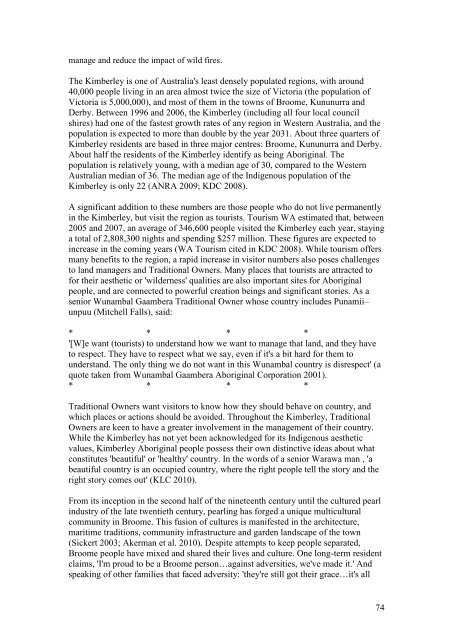WEST KIMBERLEY PLACE REPORT - Department of Sustainability ...
WEST KIMBERLEY PLACE REPORT - Department of Sustainability ...
WEST KIMBERLEY PLACE REPORT - Department of Sustainability ...
You also want an ePaper? Increase the reach of your titles
YUMPU automatically turns print PDFs into web optimized ePapers that Google loves.
manage and reduce the impact <strong>of</strong> wild fires.<br />
The Kimberley is one <strong>of</strong> Australia's least densely populated regions, with around<br />
40,000 people living in an area almost twice the size <strong>of</strong> Victoria (the population <strong>of</strong><br />
Victoria is 5,000,000), and most <strong>of</strong> them in the towns <strong>of</strong> Broome, Kununurra and<br />
Derby. Between 1996 and 2006, the Kimberley (including all four local council<br />
shires) had one <strong>of</strong> the fastest growth rates <strong>of</strong> any region in Western Australia, and the<br />
population is expected to more than double by the year 2031. About three quarters <strong>of</strong><br />
Kimberley residents are based in three major centres: Broome, Kununurra and Derby.<br />
About half the residents <strong>of</strong> the Kimberley identify as being Aboriginal. The<br />
population is relatively young, with a median age <strong>of</strong> 30, compared to the Western<br />
Australian median <strong>of</strong> 36. The median age <strong>of</strong> the Indigenous population <strong>of</strong> the<br />
Kimberley is only 22 (ANRA 2009; KDC 2008).<br />
A significant addition to these numbers are those people who do not live permanently<br />
in the Kimberley, but visit the region as tourists. Tourism WA estimated that, between<br />
2005 and 2007, an average <strong>of</strong> 346,600 people visited the Kimberley each year, staying<br />
a total <strong>of</strong> 2,808,300 nights and spending $257 million. These figures are expected to<br />
increase in the coming years (WA Tourism cited in KDC 2008). While tourism <strong>of</strong>fers<br />
many benefits to the region, a rapid increase in visitor numbers also poses challenges<br />
to land managers and Traditional Owners. Many places that tourists are attracted to<br />
for their aesthetic or 'wilderness' qualities are also important sites for Aboriginal<br />
people, and are connected to powerful creation beings and significant stories. As a<br />
senior Wunambal Gaambera Traditional Owner whose country includes Punamii–<br />
unpuu (Mitchell Falls), said:<br />
* * * *<br />
'[W]e want (tourists) to understand how we want to manage that land, and they have<br />
to respect. They have to respect what we say, even if it's a bit hard for them to<br />
understand. The only thing we do not want in this Wunambal country is disrespect' (a<br />
quote taken from Wunambal Gaambera Aboriginal Corporation 2001).<br />
* * * *<br />
Traditional Owners want visitors to know how they should behave on country, and<br />
which places or actions should be avoided. Throughout the Kimberley, Traditional<br />
Owners are keen to have a greater involvement in the management <strong>of</strong> their country.<br />
While the Kimberley has not yet been acknowledged for its Indigenous aesthetic<br />
values, Kimberley Aboriginal people possess their own distinctive ideas about what<br />
constitutes 'beautiful' or 'healthy' country. In the words <strong>of</strong> a senior Warawa man , 'a<br />
beautiful country is an occupied country, where the right people tell the story and the<br />
right story comes out' (KLC 2010).<br />
From its inception in the second half <strong>of</strong> the nineteenth century until the cultured pearl<br />
industry <strong>of</strong> the late twentieth century, pearling has forged a unique multicultural<br />
community in Broome. This fusion <strong>of</strong> cultures is manifested in the architecture,<br />
maritime traditions, community infrastructure and garden landscape <strong>of</strong> the town<br />
(Sickert 2003; Akerman et al. 2010). Despite attempts to keep people separated,<br />
Broome people have mixed and shared their lives and culture. One long-term resident<br />
claims, 'I'm proud to be a Broome person…against adversities, we've made it.' And<br />
speaking <strong>of</strong> other families that faced adversity: 'they're still got their grace…it's all<br />
74
















